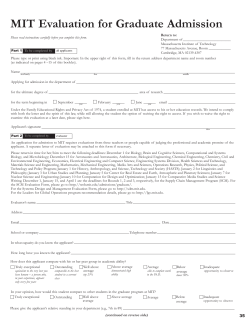
Bela Andreas Bargel Daniel Szentes Wolfgang Roller Scratch@MIT: Bela-Andreas Bargel
Bela Andreas Bargel Daniel Szentes Wolfgang Roller Scratch@MIT: Bela-Andreas Bargel Fraunhofer Gesellschaft in Germany Application oriented research 56 Institutes at 40 Locations in Germany 13 000 Employees 1 Billion € Budget Josef von Fraunhofer (Scientist, contrivance and enterpriser 1787-1826) presents his Spectrometer Scratch@MIT: Bela-Andreas Bargel Fraunhofer IITB in Karlsruhe and AST Ilmenau Representative Peking Operational Costs in 2007: 18 Mio. € Permanent employees: 182 of which scientists and eng.: 131 Additional student aides: 100 Director: Prof. Dr.-Ing. Jürgen Beyerer Chair of Interactive Realtime Systems Universität Karlsruhe (TH) Scratch@MIT: Bela-Andreas Bargel Application center system technology Ilmenau System techniques IITB Core Competences and Business Domains Image Interpretation Control Systems Technology IuK management Scratch@MIT: Bela-Andreas Bargel How to get girls involved… … in game programming? Bela Andreas Bargel Daniel Szentes Wolfgang Roller Scratch@MIT: Bela-Andreas Bargel Girls’Day – Future Prospects for Girls’? Girls’Day in Germany provides female pupils with an opportunity to gain practical insights into the world of work, particularly in technical and technology-related fields including computer science and its cognate disciplines. Scratch@MIT: Bela-Andreas Bargel Extracurricular activities for boys and girls… Beside Girls’Day we also provide independent workshops for pupils (girls and boys) of ‚Schülerakademie‛ in Karlsruhe as part of extracurricular activities in general. Scratch@MIT: Bela-Andreas Bargel Why looking for a way to motivate girls to program their own computer game? Women are still underrepresented in many technical professions including computer science and its cognate disciplines: While there has been a lot of progress in coeducation during the last centuries we still have to face numerous challenges in equal opportunities. Unfortunately many girls start losing interest already and especially during school… This should be addressed by the digital divide discourse. Scratch@MIT: Bela-Andreas Bargel Girls’Day@Fraunhofer IITB Karlsruhe As Fraunhofer Institute for Information and Data Processing (IITB), Karlsruhe, Germany, we offered several workshops the last two years: Desktop Publishing (DTP), Computer Vision, Robotics and furthermore Several sessions using Squeak, Scratch and Alice. Scratch@MIT: Bela-Andreas Bargel Setting For Girls’Day we have no advance information about how ‘tech savvy’ the girls actually are. In our workshops two pupils (age 10-13) share one laptop. This allows them to help each other easily. Of course the pupils have to negotiate how to share the ‘limited ressource’ mouse and screen. Having a small group of six pupils seems to be a quite reasonable size: Pupils might easily have a look at the others and the tutor still has enough time to help individually at the beginning if necessary. Scratch@MIT: Bela-Andreas Bargel Some working samples - Squeak A small clock: Done in the last five minutes of our first workshop (two girls, 11 and 12 years old) while using Squeak for the first time. Scratch@MIT: Bela-Andreas Bargel Some working samples - Squeak A small clock: Done in the last five minutes of our first workshop (two girls, 11 and 12 years old) while using Squeak for the first time. Their challenges: ‘painting‘ every watch hand as sole object, finding the center of rotation at the end of the watch hand, start ‘scripting‘ each object while thinking about ‛how fast is time?‛. Scratch@MIT: Bela-Andreas Bargel Some working samples – Storytelling Alice Ogre love story: Adapted storytelling tutorial (St-Alice) in german about an ogre, a pixie and the magic spells ‚Amoratus‛ and ‚Erwachikus‛... Scratch@MIT: Bela-Andreas Bargel Why are we using Scratch now? Scratch@MIT: Bela-Andreas Bargel environment ease of access from the kids perspective Squeak Etoys Scratch Alice St-Alice localization (L10N) free and direct interaction scenery painting animating using predefined objects and/or scripts storytelling online sharing “visual programming”(scripts, blocks,…) Game programming using Scratch Starting with table tennis… While a ‘hit-test’ (‘touching’) provides basic bouncing from the self-painted paddle itself the main hurdle was to connect to ‘outside world’ using ‘mouse-pointer’. Scratch@MIT: Bela-Andreas Bargel Game programming using Scratch … may result in Breakout… After some time one group added a block with hit-test and a basic version of ‚Breakout*‛ was born. * Atari Scratch@MIT: Bela-Andreas Bargel Inc., Nolan Bushnell, 1976 Game programming using Scratch … or ‘real’ Pong*. With ‘highscore’ and some more dynamic bouncing effects. * Atari Scratch@MIT: Bela-Andreas Bargel Inc., Allan Alcorn, 1972 ‘Dos‘ in general… Prepare some ideas/scenarios by yourself to be able to bridge the gap if your pupils get stuck with a problem and get lost... Having a ‘real world’ example is helpful (e.g. take a paddle and a table tennis ball to the first session and start bouncing: Ask the girls what’s happening)… Stimulate the intrinsic motivation: Help pupils to answer their questions, even ask constructive questions by yourself if necessary without using (too much) technical terminology. Scratch@MIT: Bela-Andreas Bargel ‘Dos‘ in general… Painting an object normally creates very positive emotional involvement with this object and thus is a great start. Beside Scratch also Squeak is a great tool for this setting. But also think of the ‚Get surprise sprite‛-button as not every pupil might want to paint something new. It might be hard to start from a sole ‘white paper’ (empty stage) and thus Scratch really offers help in this case. Scratch@MIT: Bela-Andreas Bargel ‘Dos‘ using Scratch… Let the children create an account at the scratch.mit.eduwebsite and integrate this into your setting: Your pupils might finish their ‘work’ for fun at home and get in contact with other’s projects. Scratch community might work as a ‚youtube for user-generated programmable media‛ here – which is a great differentiation of Scratch in comparison to other environments. Have a look at the localization of your system: Not every translation might completely fit with the sense of the word. Scratch@MIT: Bela-Andreas Bargel …and ‘don‘ts‘ in general… Be an observer (really!) . Force yourself not to do ‘ex-cathedra teaching’: Let the kids find solutions by themselves. Scratch@MIT: Bela-Andreas Bargel …and ‘don‘ts‘ especially for girls! Do not talk about mathematics and coordinate systems at the beginning as it might be associated with negative emotions. Scratch@MIT: Bela-Andreas Bargel …and ‘don‘ts‘ especially for girls! Programming should always be considered from the perspective of the pupil: If ‘high-scores’ aren’t of interest for some girls, do not lead them into that direction: Have a look what keeps them motivated: Making the object as beautifully as possible: -> painting Having ‘something’ that follows the mouse: -> manipulating and interaction Or something that’s doing something on its own: -> e.g. animation Or tells a story: -> storytelling with speech balloons Scratch@MIT: Bela-Andreas Bargel …and the last one: Even if science is fun… …do not talk about ‚the science of…‛: Instead have a look what elements might be just fun :-) Be open minded to see what your pupils will do… …and you won’t be the ‘teacher’ for the whole time. Scratch@MIT: Bela-Andreas Bargel Thank you for your attention Girls’Day 2008@IITB Scratch@MIT: Bela-Andreas Bargel Something to read – authoring environments Scratch: Storytelling Alice: scratch.mit.edu alice.org ‚ Scratch: A Sneak Preview. ‚ by J. Maloney, L. Burd, Y. Kafai, N. Rusk, B. Silverman and M. Resnick ‚Lessons Learned from Designing a Programming System to Support Middle School Girls Creating Animated Stories‛ by Caitlin Kelleher and Randy Pausch ‚ScratchR: a platform for sharing usergenerated programmable media‛ by Monroy-Hernández Squeak: squeakland.org ‚Squeak Etoys Authoring & Media‛ by Alan Kay ‚Drive A Car‚ by Alan Kay Scratch@MIT: Bela-Andreas Bargel Croquet: opencroquet.org ‚OpenCroquet: A Menagerie of New User Interfaces‛ by David Smith, Andreas Raab , David Reed and Alan Kay Something to read – more general ‚A Personal Computer for Children of All Ages‚ and ‚Doing With Images Makes Symbols‛ by Alan Kay ‚All I Really Need to Know (About Creative Thinking) I Learned (By Studying How Children Learn) in Kindergarten‛ by Mitchel Resnick ‚The Children's Machine: Rethinking School In The Age Of The Computer‚ by Seymour Papert Of course Jean Piaget,… German readers may also have a look at Hilbert Meyer in general. DynaBook by Alan Kay 1972 Scratch@MIT: Bela-Andreas Bargel Contact Bela-Andreas.Bargel@iitb.fraunhofer.de Daniel.Szentes@iitb.fraunhofer.de Wolfgang.Roller@iitb.fraunhofer.de Fraunhofer Institute for Information and Data Processing Business Division: Interoperability and Assistance Systems Fraunhoferstraße 1, 76131 Karlsruhe, Germany http://www.iitb.fraunhofer.de/?GD 08 Scratch@MIT: Bela-Andreas Bargel
© Copyright 2025












